A History of Outreach to the Community: Raleigh’s Saint Monica School
Back in February of this year a miracle, of sorts, took place at 15 Tarboro St. in East Raleigh. I am speaking of course, of the official opening of the St. Monica Teen Center. The city-sponsored facility provides a safe haven for neighborhood teenagers for after school activities, recreation and interaction with other teens and adults.
The Center has a computer lab, a homework assistance area, a fitness/dance space and a youth lounge, among other amenities. Under the jurisdiction of the Raleigh Parks and Recreation Department, the center has a full-time director, and is the first such teen-oriented facility funded by the City of Raleigh. In its three short months of operation, the Teen Center is already having a positive effect on the community.
Located at the corner of Tarboro and E. Edenton streets, the Teen Center is housed in the historic St. Monica School building, which has a long history of serving the youth of the community.
In 1930 Raleigh’s first Roman Catholic bishop, the Most Reverend William Hafey, purchased the old Ferrall estate on New Bern Ave. for $100 and established St. Monica parish and school. His was a noble effort to minister to not only Raleigh’s tiny African-American Catholic community of the time, but to the greater community, as well.
The school opened in the Fall of 1930, and was staffed by five nuns from the Sisters the of Immaculate Heart of Mary order, based in Scranton, PA. The old Ferrall homeplace served as their convent.
Bishop Hafey (seen here in episcopal vestments), is accompanied by Fr. Thomas Griffin, rector of Sacred Heart Cathedral and founder of Cathedral School, at the dedication ceremony of St. Monica School in 1930.
St. Monica School consisted of four large classrooms of equal size, one of which doubled as the school’s chapel. A small office adjoined each of the classrooms. It was modeled after a similar structure erected in Greensboro, also under the jurisdiction of the Diocese of Raleigh. At its peak of operation during the 1940s and ’50s, the 4-acre campus included the brick school building, the convent, a “domestic training school,” a rectory, St. Monica Church itself and a small school auditorium.
This is how the old Ferrall homeplace appeared in 1930 when it served as the convent for the Sisters IHM, the teachers who staffed St. Monica School. It stood at the corner of New Bern Ave. and Tarboro St.
Later on, during the civil rights era, St. Monica School was a proud witness to the early desegregation of schools in Raleigh. In 1953 Bishop Vincent Waters (third bishop of Raleigh, 1945-1975) decreed that racial segregation in Catholic parishes and schools in his diocese should end. The following year St. Monica graduates were allowed admittance to Cathedral High School, making it the first integrated school in North Carolina.
By 1967, all St. Monica students had been incorporated into Cathedral School, and the diocese subsequently closed St. Monica. The parish itself was decommissioned in 1968. In 1972 the campus property was sold to the City of Raleigh.
In the subsequent decade a private individual purchased the Ferrall house and moved it to another site. A Bojangles restaurant was later built on the vacant lot. The rectory, training school building, the auditorium and church building were demolished one by one until only the school building itself remained. Then in the early 1980s Edenton St. was extended through the property to connect with New Bern Ave. Thus the vivisection was complete.
For many years thereafter the old St. Monica building was occupied by the New Bern Ave. Day Care Center, until it ultimately vacated the premises, as well. Later, through the efforts of local preservationists, the City of Raleigh designated the venerable old building as a Raleigh Historic Landmark in 2008.
The traverse hall of St. Monica School. I can easily picture Sister Mary Benedicta hustling down the corridor at the first period bell on her way to greet her classroom of eager students.
Editor’s note: Saint Monica was the mother of Saint Augustine, the fourth century Bishop of Hippo, in Africa. She is revered by the Catholic Church as the patron of abuse victims, alcoholics, victims of adultery, disappointing children, widows, married women, and mothers.
Archival photos of St. Monica School courtesy North Carolina State Archives
Â

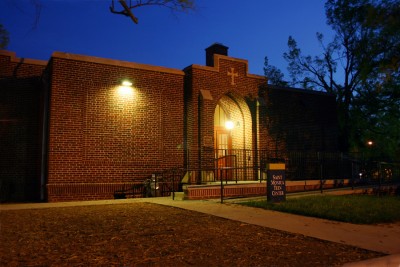
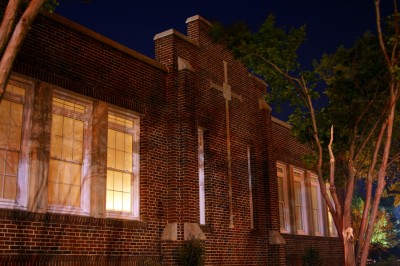

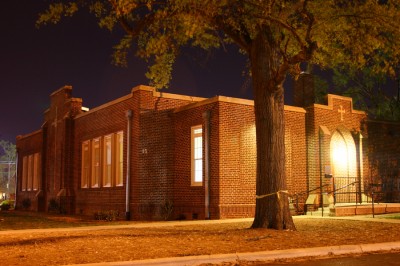
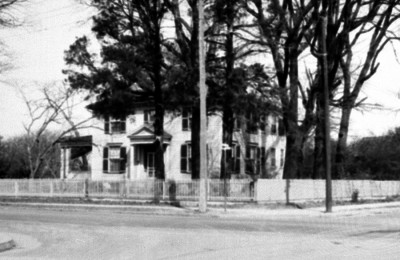

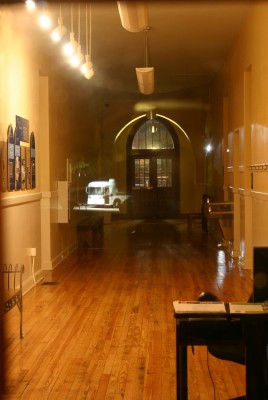
 Sign up for the Newsletter
Sign up for the Newsletter
05/19/2011
Where was the Ferrell homeplace moved? Is it still standing?
08/01/2011
The Ferrell homeplace was bought moved to a street named Brasslight rd something like that off of Durant Rd in Raleigh. As a child the nuns would call my father over there if they got scared
08/01/2011
The Ferrell homeplace was bought moved to a street named Brasslight rd something like that off of Durant Rd in Raleigh
08/01/2011
We used to go and help the nuns clean that big house too! Once a bird got caught up in the drapes, and my father went over there to get the bird out of the house. We had a lot of fun rambling around in that convent!
08/02/2011
I remember when there used to be a little grotto there with a statue of the Virgin Mary. Wonder what happened to it.
08/03/2011
Zelda — Thanks much for sharing your memories of the nuns at St Monica’s. Did you happen to know the Hadden family who lived on Tarboro St across the street from the school?
Also, thanks for the info on the location of the old Ferrell place. There’s a ‘Brassfield Rd’ off Durant out that way — maybe that’s where it was moved to.
NCSU — Yes, I remember that little grotto too. It was located between the convent and the school building — where Edenton St goes through now. When the property was sold, the grotto was moved to the grounds of Sacred Heart Cathedral, where it can be seen today. It’s in the rectory garden behind the church.
02/20/2017
My mother attended St. Monica in 1932 through 8th grade. Where can I found anything archived such as pictures.
02/20/2017
I also am looking for photos from the Saint Monica’s dedication. I attended and also grew up across from the school
I am thinking that there must be some in the NC Archives; I also am pretty sure that there are some being held by the Diocese of Raleigh.
11/25/2017
I attended St Monica’s from 1950 to 1958. A couple of years ago I returned to Raleigh and stopped by the old school building which is now listed as a historical site and used as a teen center. My visit was a true walk down memory lane. There were quite a few pictures of some of the students on display.. I recognized one with my sister Duanna “Doll Baby†Freeman who attended from 1952 to 1960..
12/28/2022
Did you happen to know the Hadden family who lived on Tarboro St across the street from the school?
@RaleighBoy. She is the daughter of the Hadden [Willor Alston] Family. Niece of Msgr. Thomas Paul. Hadden –
( Msgr. Thomas P. Hadden – Saint Meinrad Alumni)
https://www.facebook.com/zelda.h.mccullers/
Zelda Mccullers
12/28/2022
Did you happen to know the Hadden family who lived on Tarboro St across the street from the school?
RaleighBoy. She is the daughter of the Hadden [Willor Alston] Family. Niece of Msgr. Thomas Paul. Hadden –
( Msgr. Thomas P. Hadden – Saint Meinrad Alumni)
https://www.facebook.com/zelda.h.mccullers/
Zelda Mccullers
12/28/2022
Did you happen to know the Hadden family who lived on Tarboro St across the street from the school?
RaleighBoy. She is the daughter of the Hadden [Willor Alston] Family. Niece of Msgr. Thomas Paul. Hadden –